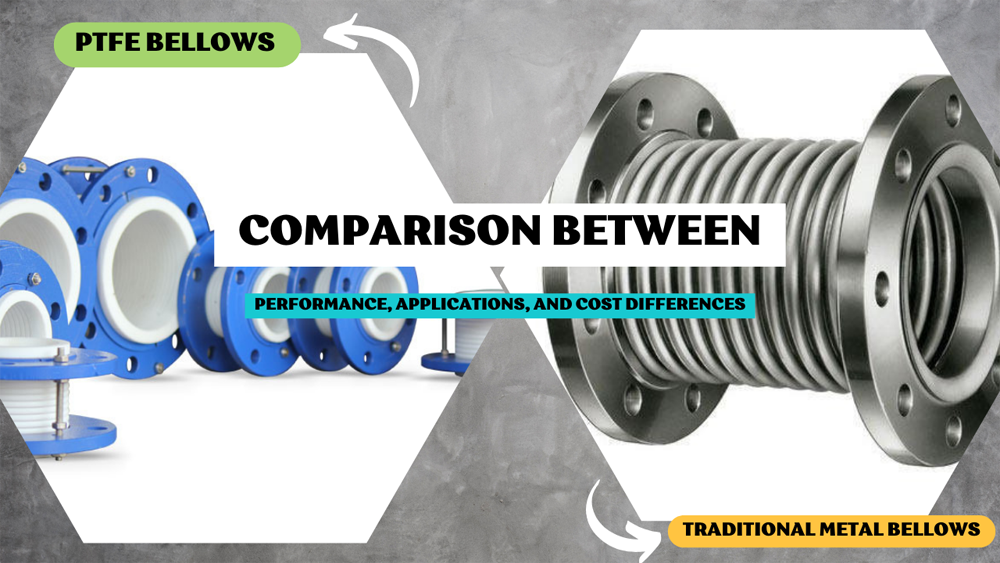
PTFE bellows and traditional metal bellows are essential components in various industrial applications, offering unique advantages based on their material properties. Understanding the differences between these two types of bellows can help in selecting the right one for specific operational requirements. This article provides a detailed comparison to guide decision-making in selecting the appropriate bellows for diverse industrial needs.
PTFE Bellows: Known for their excellent chemical resistance, flexibility, and low friction. They can withstand a wide range of temperatures and aggressive chemicals, making them ideal for corrosive environments.
Traditional Metal Bellows: Typically made from stainless steel or other alloys, metal bellows offer high strength and durability. They are suitable for high-pressure applications and can handle extreme temperatures, both high and low.
| Property | PTFE Bellows | Traditional Metal Bellows |
| Material Composition | Polytetrafluoroethylene (PTFE) | Stainless steel, Inconel, Hastelloy |
| Chemical Resistance | Excellent, resistant to most chemicals including acids, bases, and solvents | Varies, good resistance to many chemicals but can corrode with certain substances |
| Temperature Range | -200°C to +260°C | -270°C to +800°C (depending on alloy) |
| Flexibility | High, allows for significant lateral and angular movements | Moderate, primarily axial movement |
| Tensile Strength | Lower compared to metals | High tensile strength, varies by alloy |
| Durability | Good in chemical environments, less durable in abrasive conditions | Excellent in high-pressure and high-temperature applications |
| Weight | Light | Heavier |
| Thermal Conductivity | Low, good for insulation purposes | High, better heat dissipation |
| Friction Coefficient | Low, reduces wear in dynamic applications | Higher, depending on surface treatment |
| Aging and Degradation | Resistant to aging, maintains properties over time | May require surface treatment to prevent corrosion and aging |
| Manufacturability | Easier to manufacture with lower costs | Complex manufacturing processes, higher costs |
PTFE Bellows: Commonly used in chemical processing, pharmaceuticals, food and beverage industries, and other applications where corrosion resistance is crucial. They are also used in semiconductor manufacturing and ultra-pure water systems.
Traditional Metal Bellows: Preferred in industries where high pressure and temperature conditions are prevalent, such as oil and gas, power generation, aerospace, and automotive sectors. They are also used in HVAC systems and industrial machinery.
| Industry | PTFE Bellows Applications | Traditional Metal Bellows Applications |
| Chemical Processing | Handling corrosive chemicals and acids | High-pressure and high-temperature pipelines |
| Pharmaceuticals | Ultra-pure water systems, drug manufacturing | Equipment exposed to high temperatures |
| Food and Beverage | Hygienic applications, non-reactive surfaces | High-pressure steam lines and pasteurization equipment |
| Semiconductors | Cleanroom environments, chemical delivery systems | Equipment requiring high structural integrity |
| Oil and Gas | Limited use due to lower pressure tolerance | High-pressure oil and gas pipelines |
| Aerospace | Not commonly used | Components requiring high strength and temperature resistance |
| Power Generation | Limited use | Turbine and boiler components exposed to high temperatures |
PTFE Bellows: Offer superior flexibility and can accommodate greater lateral and angular movements. Their flexibility makes them ideal for applications where thermal expansion and contraction are significant concerns.
Traditional Metal Bellows: While they provide good flexibility, they are generally more rigid compared to PTFE bellows. They are best suited for applications requiring axial movement and where structural integrity is paramount.
| Movement Type | PTFE Bellows | Traditional Metal Bellows |
| Lateral Movement | Excellent, can handle significant lateral displacement | Moderate, limited by structural rigidity |
| Angular Movement | Excellent, accommodates greater angular displacement | Limited, primarily designed for axial movement |
| Axial Movement | Good, but not as high as metal bellows | Excellent, designed for axial compression and expansion |
| Thermal Expansion | Excellent, compensates for thermal expansion and contraction | Good, but requires precise engineering for high temperature changes |
| Vibration Absorption | Good, dampens vibrations due to flexibility | Moderate, depends on the design and material used |
PTFE Bellows: Generally more cost-effective due to the lower price of PTFE material and simpler manufacturing processes. They are lighter and easier to install, reducing labor costs and installation time.
Traditional Metal Bellows: Typically more expensive due to the cost of raw materials and the complexity of manufacturing. Installation can be more labor-intensive, requiring skilled personnel and specialized equipment.
| Aspect | PTFE Bellows | Traditional Metal Bellows |
| Material Cost | Lower, PTFE is generally cheaper | Higher, metal alloys are expensive |
| Manufacturing Cost | Lower, simpler processes | Higher, complex manufacturing and precision engineering required |
| Installation Time | Shorter, easier to handle and install | Longer, requires skilled labor and specialized tools |
| Labor Cost | Lower, less labor-intensive | Higher, more labor-intensive due to complexity |
| Maintenance Cost | Lower, resistant to chemicals and corrosion | Higher, regular maintenance and inspections needed |
| Overall Cost | Generally more cost-effective | Higher due to material and labor costs |
PTFE Bellows: Offer excellent longevity in corrosive environments but may have a shorter lifespan in high-pressure or abrasive conditions. Maintenance is relatively low due to their resistance to chemicals and corrosion.
Traditional Metal Bellows: Highly durable in high-pressure and high-temperature applications but can be susceptible to corrosion if not properly protected. Regular maintenance and inspections are required to ensure long-term performance.
| Durability Factor | PTFE Bellows | Traditional Metal Bellows |
| Corrosion Resistance | Excellent, highly resistant to chemical corrosion | Varies, good resistance but can corrode with certain substances |
| Abrasion Resistance | Moderate, not ideal for abrasive environments | Excellent, can withstand abrasive conditions |
| Pressure Tolerance | Lower, not suitable for high-pressure applications | High, designed for high-pressure environments |
| Temperature Tolerance | Good, suitable for a wide temperature range | Excellent, can handle extreme temperatures |
| Maintenance Requirements | Low, minimal maintenance due to chemical resistance | High, requires regular inspections and maintenance |
| Longevity | Long-lasting in corrosive environments | Long-lasting in high-pressure and high-temperature applications |
Selecting between PTFE bellows and traditional metal bellows involves considering factors such as chemical compatibility, temperature and pressure conditions, cost, and maintenance requirements. PTFE bellows excel in environments requiring high corrosion resistance and flexibility, while traditional metal bellows are better suited for high-pressure and high-temperature applications. Understanding these distinctions ensures optimal performance and longevity in various industrial applications.
Feel free to leave your message on our board. If you're looking to inquire about prices or place an order, this is the right place! Let us know the details of your needs, and our team will get back to you with a personalized quote as quickly as possible. We're here to ensure your experience is seamless and satisfactory. Share your requirements or ask any questions you might have - we're eager to assist and look forward to doing business with you!
Name:Tim
Phone:+86-15716151880
Email:[email protected]
Company:BEANT
Address:No. 28, Luoshen Road, Luoshe Town, Huishan District, Wuxi City, Jiangsu Province
